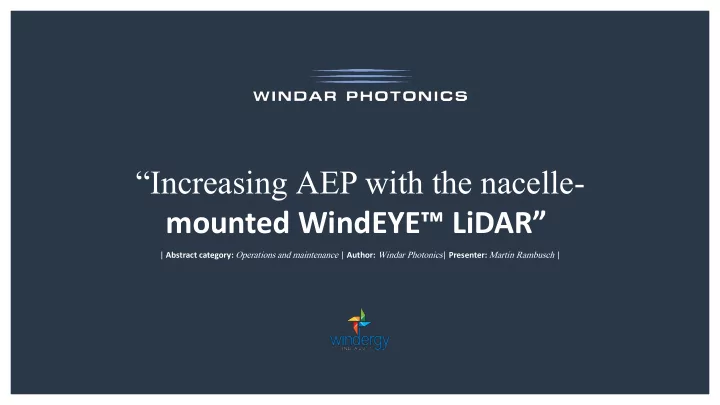

“Increasing AEP with the nacelle - mounted WindEYE™ LiDAR” | Abstract category: Operations and maintenance | Author: Windar Photonics | Presenter: Martin Rambusch |
WindEYE™ LiDAR Standard Anemometry • Positioned at the rear part of the nacelle roof. • Measures the wind when it has passed the rotor. • Provides a distorted measurement of the wind direction • Results in a turbine that is constantly being slightly misaligned LiDAR • By utilizing the Doppler Effect, the WindEYE™ is able to measure the movement of aerosols in the air 80m in front of the turbine • The wind direction and wind speed are calculated from the aerosol measurements • Measures the wind direction before the wind has passed the rotor.
Yaw misalignment Yaw misalignment Yaw misalignment occurs when the turbine is not aligned with the oncoming wind. • Less energy production • Increased load cycles • More wear and tear AEP increases from correcting yaw misalignment Correcting yaw misalignment results in: • Increases Energy production (AEP) • Reduced Loads
LiDAR Integration w. Wind turbine control system Retrofit Direct integration &
“ … It was found that the WindEYE™ measured the wind direction with a high accuracy during the whole campaign.” DTU VERIFICATION The WindEYE™ has been verified by DTU Risø ( Dellwik et al, Feb. 2015): “The field experiment utilised two sonic anemometers, which were located in the two centers of the measurement volumes of the WindEYE™, as reference instruments. The wind vectors measured by the sonic anemometers were projected onto the line-of-sight directions of the WindEYE™ and the wind direction was calculated based on the WindEYE™ algorithm…” Setup of the experiment: A. Positions of sonic anemometer masts and WindEYE ™ at Risø campus, DTU, B. Photo of experiment.
DTU Verification – Correlation The following two diagrams displays the correlation concerning wind speed and wind direction between the measurements of the Windar Photonics LiDAR and met. masts from the test at DTU Risø: Wind Direction Wind Speed
Correlation Analysis – Met. Mast vs. WindEYE ™ & WindEYE ™ vs. ultrasonic sensor The following two diagrams display the correlation between the measurements of the Windar Photonics LiDAR and an ultrasonic wind sensor on a wind turbine, and between the Windar Photonics LiDAR and a met. mast. WindEYE ™ and WindEYE ™ Ultrasonic and Wind Met. Mast Sensor
The measurements and calculations are collected and Protocol and Data stored in an accessible ASCII format in accordance with the below protocol list: Protocol list from RS485 Protocol Specification Unit YYYY/MM/DD Timestamp HH:MM:SS Vlos1 Measured Wind speed along beam 1 Cm/s Vlos2 Measured Wind speed along beam 2 Cm/s U Calculated Lateral Wind speed Cm/s W Calculated Axial Wind speed Cm/s V Calculated Incoming Wind speed Cm/s Phi ( Φ ) Calculated Misalignment angle °x100 Status 1 second measurement Status 0/1 – Bad/Good
Data handling AEP-gains calculation methodology • The 3 minutes average data wind speed data is The AEP calculations are comprised of calculations based on both an empirical method (utilising cos^2) and a normalised according to the IEC-61400-12-1 standard. theoretical method (utilising cos^3). The final AEP- • The data realignment, if a WindTIMIZER was installed, increase estimate will be an average between the two is derived from an in-house algorithm that accounts for methods. the 3 minutes delay between the measurement and COS^2 the yaw action of the turbine. The AEP gain is then calculated from the below equation for both the mean and the absolute mean realignment utilising cos^2: • The probability Density Function of each wind speed is derived from the site’s Weibull parameters. • The wind speed, data measured, and the realigned COS^3 data are then binned according to the IEC-61400-12-1 The AEP gain is then calculated from the below equation for both standard. Their mean and absolute mean are then the mean and the absolute mean realignment utilising cos^3: calculated. Finally, the two AEP gain calculations are averaged to produce the final AEP gain estimate, which is presented in the project report.
Measurement campaign results 2MW Wind Turbine - Estimated AEP gain 2.05%
Measurement campaign results 1.5MW Wind Turbine w. WindTIMIZER
Realignment of a 1.5MW wind turbine with the WindTIMIZER Yaw misalignment estimation [°] before and after WindTIMIZER activation for test the turbine T11. Data provided with a 10-min resolution
SUZLON 2.1MW SIEMENS 3.6MW In general, Windar has seen increases to AEP by 1-4%, which averages out to about 1.5% across 200 installations GAMESA G87 2MW GAMESA G87 2MW VESTAS V100 1.8MW NORDEX 2.5MW VESTAS V80 2MW VESTAS V80 2MW
More than 200 commercial projects, including: • Siemens 2. 3MW, 3.6MW, 4.0MW & 6. 0MW VERIFIED BY • Vestas V47, V80, V90, V100 the Technical University of Denmark - • Suzlon S111 2.1MW, DTU Risø S88 2.1MW • GE 1. 5MW & 1.7MW • Envision 3. 6MW & 4.0MW • Gamesa 2MW • Neg-Micon 600kW Currently being evaluated by NIWE & 1. 65MW • NIWE is operating under an R&D mandate to Nordex N90 assist the Indian wind industry by evaluating • Senvion 2MW solutions that can improve wind turbine • Sinovel 1. 5MW performance; the Windar LiDAR is being • Dongqi 1. 5MW evaluated by NIWE concerning the LiDAR’s • Lagerwey 0. 9MW potential for impacting AEP and the lifetime of • Windey 750kW wind turbines. • United Power 3MW • CSIC 2MW
Recommend
More recommend